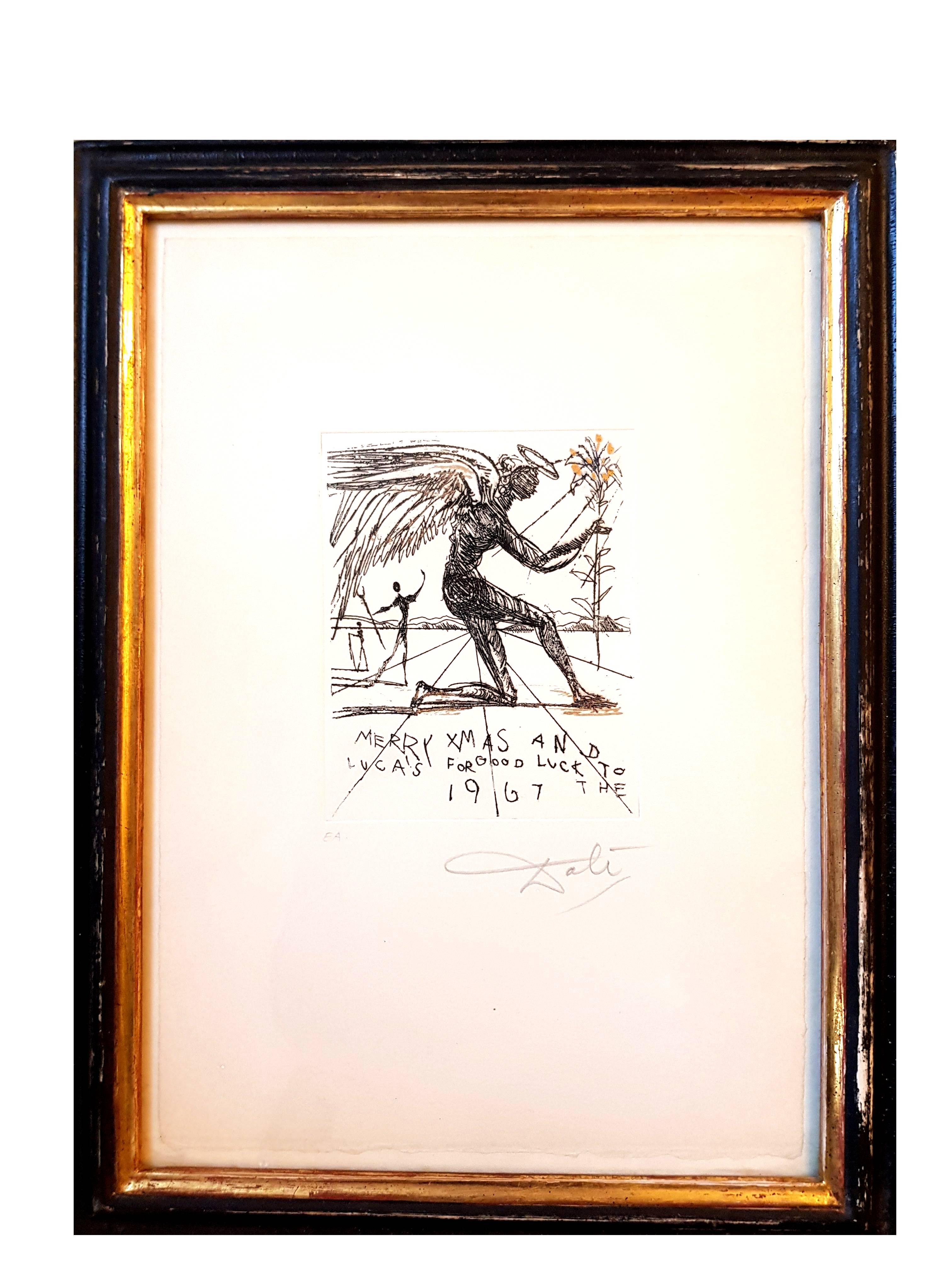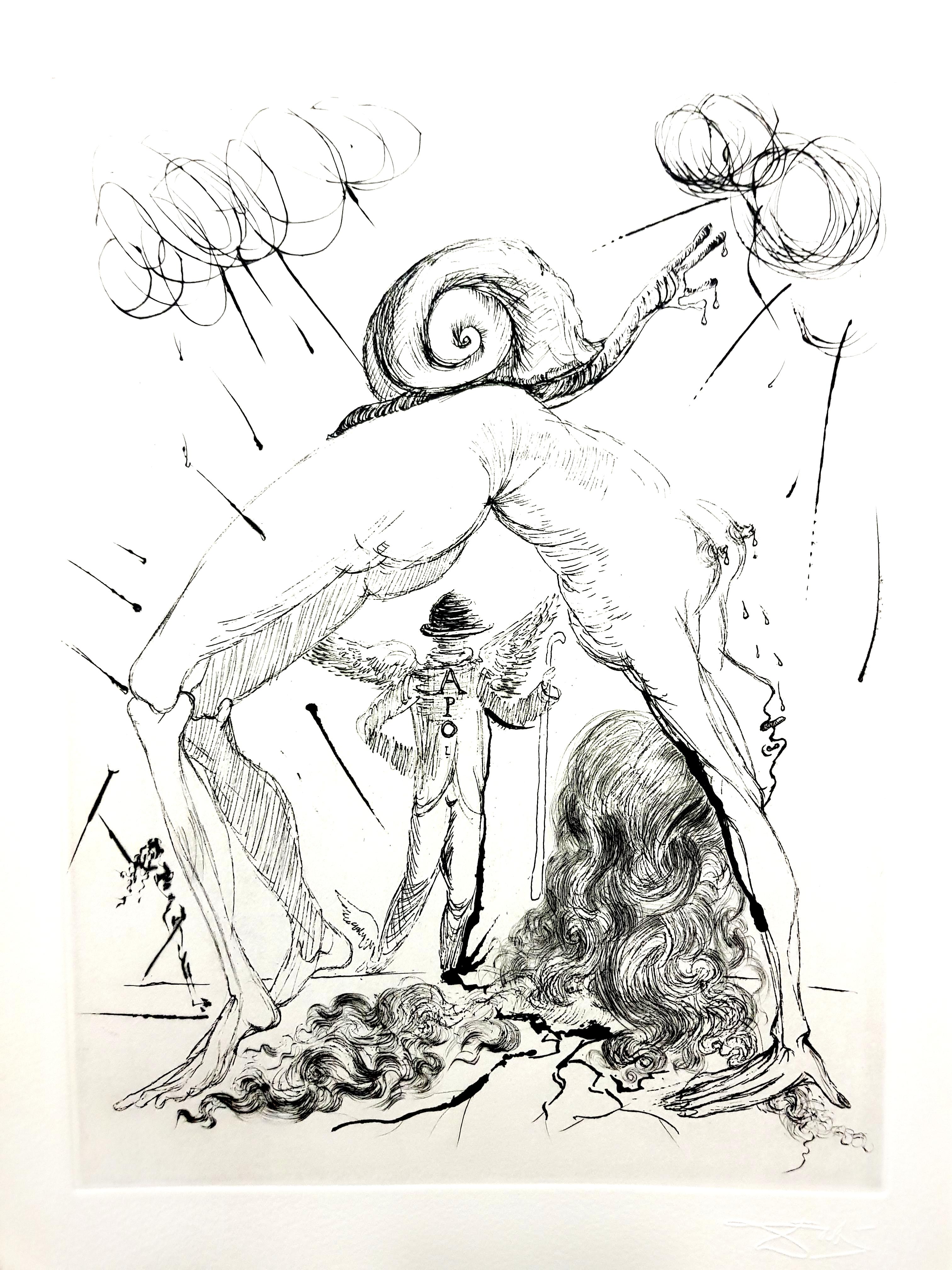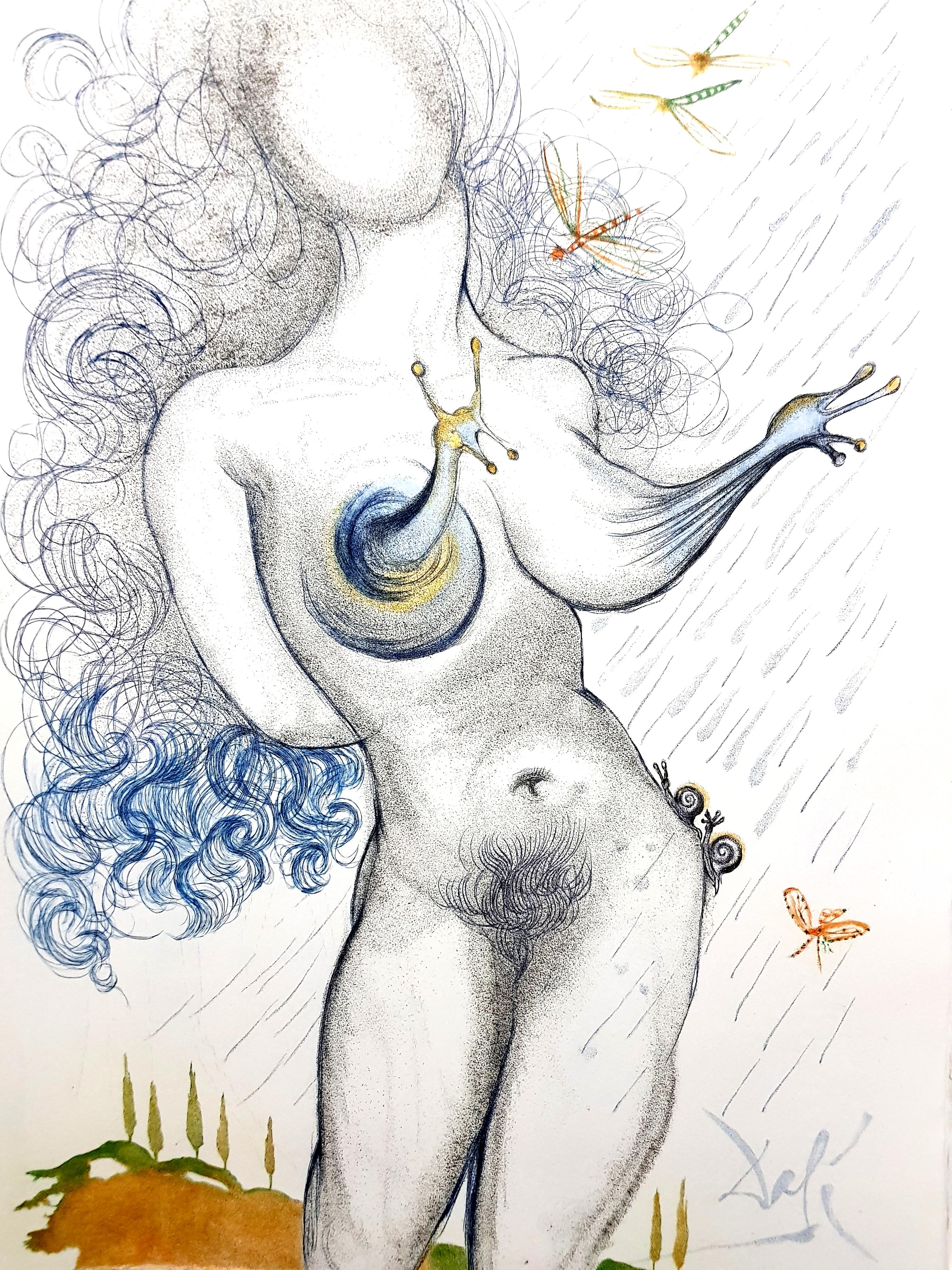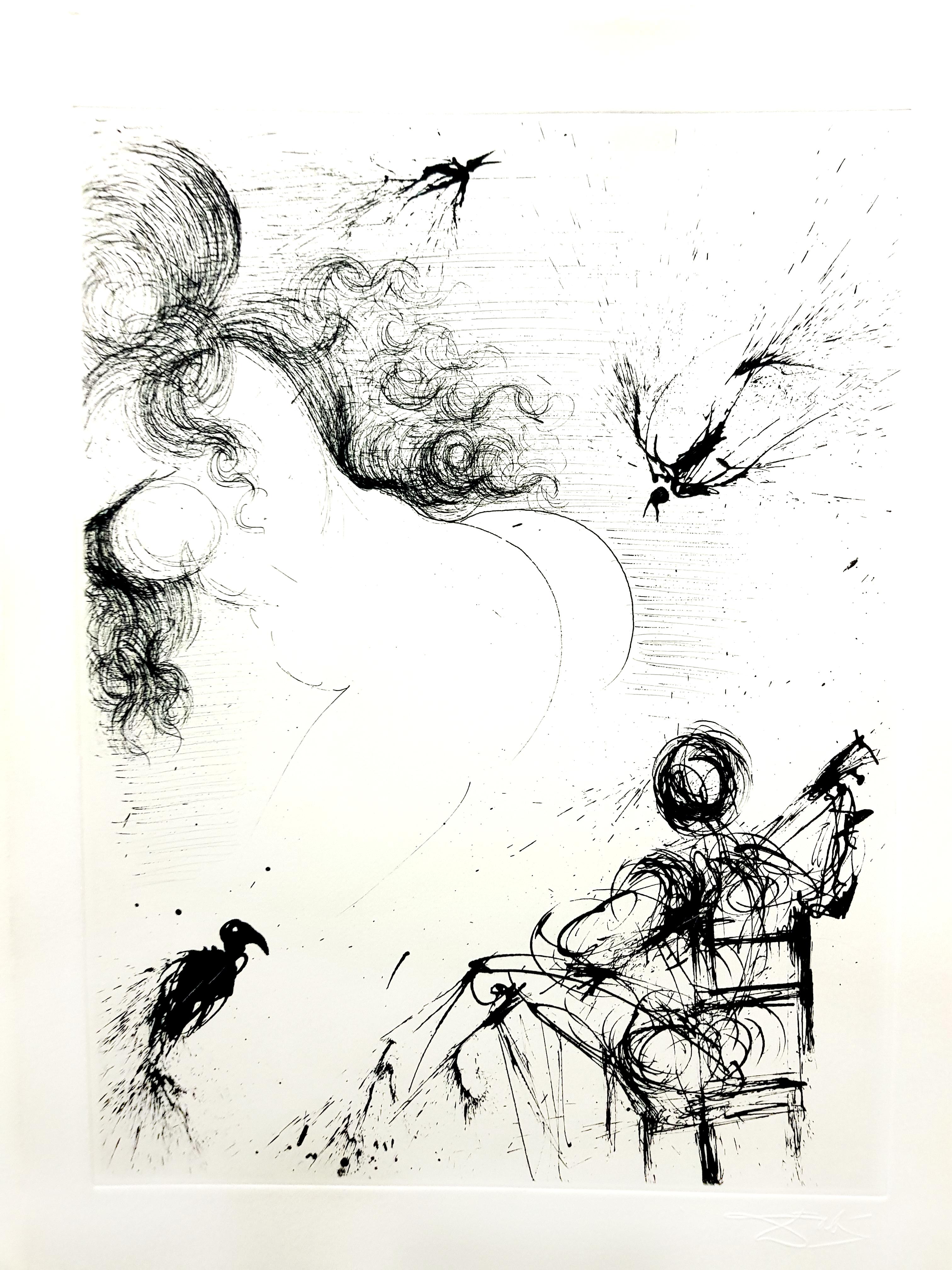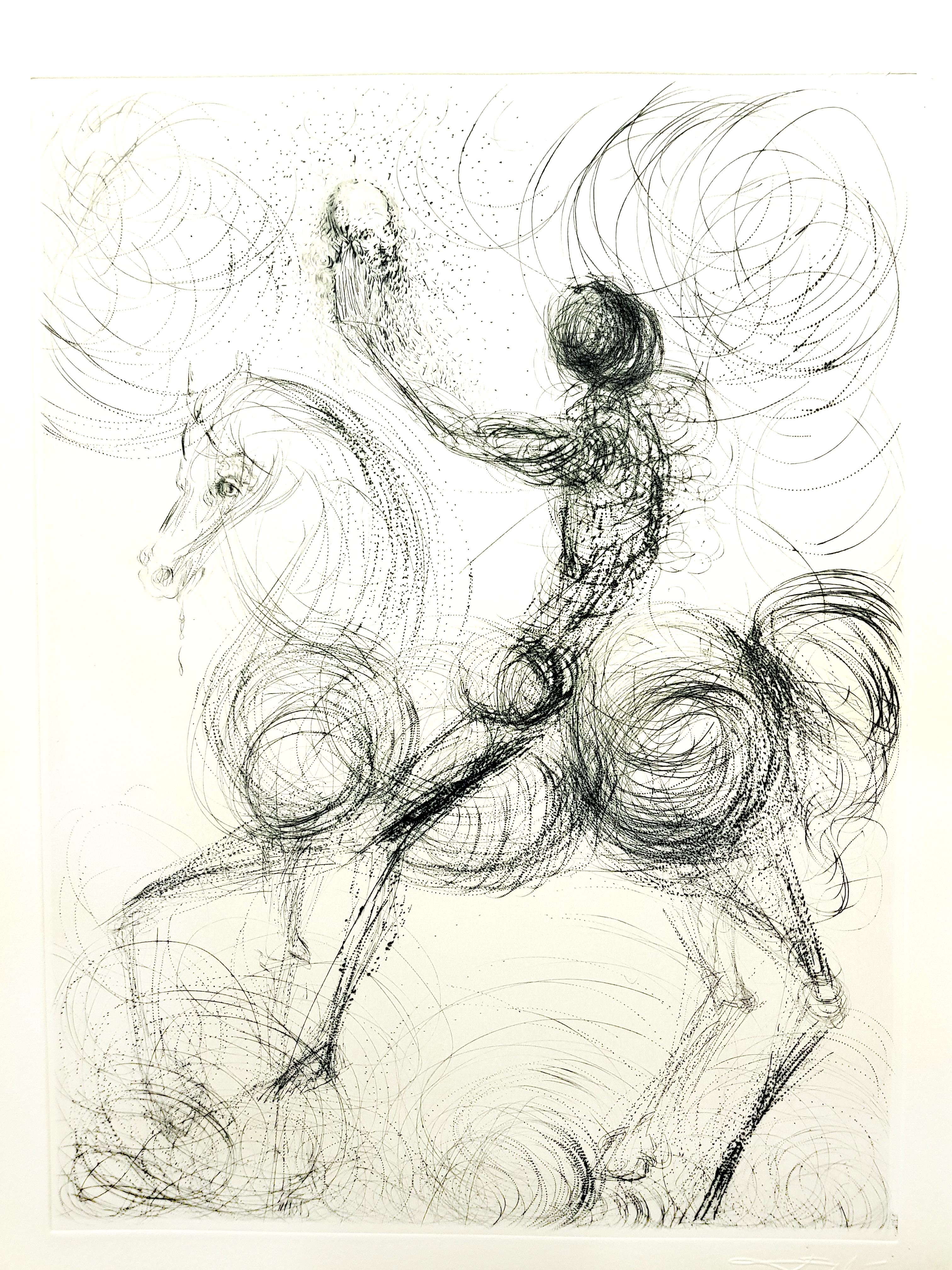Items Similar to Salvador Dali - John Kennedy - Original Handsigned Etching
Want more images or videos?
Request additional images or videos from the seller
1 of 11
Salvador Dali - John Kennedy - Original Handsigned Etching1968
1968
About the Item
Salvador Dali - John Kennedy - Original Handsigned Etching
Dimensions: 38 x 28 cm
1968
Signed in pencil
EA in Sanguine
Jean Schneider, Basel
References : Field 68-8
Salvador Dali
Salvador Dali was born as the son of a prestigious notary in the small town of Figueras in Northern Spain. His talent as an artist showed at an early age and Salvador Felipe Jacinto Dali received his first drawing lessons when he was ten years old. His art teachers were a then well known Spanish impressionist painter, Ramon Pichot and later an art professor at the Municipal Drawing School. In 1923 his father bought his son his first printing press.
Dali began to study art at the Royal Academy of Art in Madrid. He was expelled twice and never took the final examinations. His opinion was that he was more qualified than those who should have examined him.
In 1928 Dali went to Paris where he met the Spanish painters Pablo Picasso and Joan Miro. He established himself as the principal figure of a group of surrealist artists grouped around Andre Breton, who was something like the theoretical "schoolmaster" of surrealism. Years later Breton turned away from Dali accusing him of support of fascism, excessive self-presentation and financial greediness.
By 1929 Dali had found his personal style that should make him famous the world of the unconscious that is recalled during our dreams. The surrealist theory is based on the theories of the psychologist Dr. Sigmund Freud. Recurring images of burning giraffes and melting watches became the artist's surrealist trademarks. His great craftsmanship allowed him to execute his paintings in a nearly photo-realistic style. No wonder that the artist was a great admirer of the Italian Renaissance painter Raphael.
Salvador Dali and Gala.
Meeting Gala was the most important event in the artist's life and decisive for his future career. She was a Russian immigrant and ten years older than Dali. When he met her, she was married to Paul Eluard.
Gala decided to stay with Dali. She became his companion, his muse, his sexual partner, his model in numerous art works and his business manager. For him she was everything. Most of all Gala was a stabilizing factor in his life. And she managed his success in the 1930s with exhibitions in Europe and the United States.
Gala was legally divorced from her husband in 1932. In 1934 Dali and Gala were married in a civil ceremony in Paris and in 1958 in church after Gala's former husband had died in 1952. However from around 1965 on, the couple was seen less frequently together. But Gala continued to manage Dali's business affairs.
1933 Salvador Dali had his first one-man show in New York. One year later he visited the U.S. for the first time supported by a loan of US$500 from Pablo Picasso. To evade World War II, Dali chose the U.S.A. as his permanent residence in 1940. He had a series of spectacular exhibitions, among others a great retrospective at the Museum of Modern Art in New York.
Besides creating a number of great paintings, Dali caused the attention of the media by playing the role of a surrealist clown. He made a lot of money and was contemptuously nicknamed Avida Dollars (greedy for dollars) by Andre Breton.
Dali became the darling of the American High Society. Celebrities like Jack Warner or Helena Rubinstein gave him commissions for portraits. His art works became a popular trademark and besides painting he pursued other activities - jewelry and clothing designs for Coco Chanel or film making with Alfred Hitchcock.
The Classic Period After World War II
In 1948 Dali and Gala returned to Europe, spending most of their time either in their residence in Lligat or Spain or in Paris or France or in New York. Dali developed a lively interest in science, religion and history. He integrated things into his art that he had picked up from popular science magazines.
Another source of inspiration were the great classical masters of painting like Raphael, Velasquez or the French painter Ingres. The artist commented his shift in style with the words: "To be a surrealist forever is like spending your life painting nothing but eyes and noses."
In 1958 the artist began his series of large sized history paintings. He painted one monumental painting every year during the summer months in Lligat. The most famous one, The Discovery of America by Christopher Columbus, can be seen at the Dali Museum in St. Petersburg in Florida. It is breath-taking. The artist's late art works combine more than ever his perfect and meticulous painting technique with his fantastic and limitless imaginations.
Salvador Dali is the only known artist who had two museums dedicated exclusively to his works at lifetime.
Dali Museum in St. Petersburg, Florida
The Dali Museum in St. Petersburg in Florida or U.S.A. was founded in 1971 by the Dali collector A. Reynolds Morse and his wife Eleanor. The collection was first exhibited in a building adjacent to their home in Cleveland/Ohio.
In 1982, the museum was moved to St. Petersburg in Florida. It hosts 95 oil paintings including six of Dali's eighteen large-sized historical paintings.
Dali Museum-Theater in Figueres, Spain.
The Dali Museum-Theater in Figueres, Spain was the former Municipal Theater of Figueres. In 1918, when Salvador Dali was only fourteen years old, it had shown his first public exhibition.
Since 1970 the artist had dedicated his energy to transform the former Municipal Theater into a museum and art gallery. In 1974 the Theatro Museo Dali was officially opened.
1980 Dali was forced to retire due to palsy, a motor disorder, that caused a permanent trembling and weakness of his hands. He was not able to hold a brush any more. The fact that he could not follow his vocation and passion of painting and the news of Gala's death in 1982 left him with deep depressions.
After Gala's death he moved to Pubol, a castle, he had bought and decorated for Gala. In 1984, when he was lying in bed, a fire broke out and he suffered sever burns. Two years later, a pacemaker had to be implanted.
Towards the end of his life, Dali lived in the tower of his own museum where he died on January 23, 1989 from heart failure.
- Attributed to:Salvador Dalí (1904 - 1989, Spanish)
- Creation Year:1968
- Dimensions:Height: 14.97 in (38 cm)Width: 11.03 in (28 cm)Depth: 0.04 in (1 mm)
- Medium:
- Movement & Style:
- Period:
- Condition:
- Gallery Location:Collonge Bellerive, Geneve, CH
- Reference Number:1stDibs: LU16127063532
About the Seller
4.9
Gold Seller
These expertly vetted sellers are highly rated and consistently exceed customer expectations.
Established in 2015
1stDibs seller since 2015
910 sales on 1stDibs
Typical response time: 1 hour
- ShippingRetrieving quote...Ships From: Collonge Bellerive, Geneve, Switzerland
- Return PolicyA return for this item may be initiated within 7 days of delivery.
More From This SellerView All
- Salvador Dali - Merry Xmas - Original HandSigned EtchingBy Salvador DalíLocated in Collonge Bellerive, Geneve, CHOriginal Handsigned Etching by Salvador Dali Hand-Enhanced with Gold painting Title: Merry Christmas Signed in pencil Edition: EA Dimensions: 23 x 17.5 cm Publisher : Phyllis Lucas Gallery...Category
1960s Surrealist Figurative Prints
MaterialsEtching
- Salvador Dali - Nude with SnailBy Salvador DalíLocated in Collonge Bellerive, Geneve, CHSalvador Dali - Nude with Snail - Original Etching Dimensions: 38 x 28 cm Edition: 235 1967 embossed signature On Arches Vellum References : Field 67-10 (p. 34-35)Category
1960s Surrealist Nude Prints
MaterialsEtching
- Salvador Dali - Nude with Snails BreatsBy Salvador DalíLocated in Collonge Bellerive, Geneve, CHSalvador Dali - Nude with Snails Breats - Original Etching Dimensions: 38 x 28 cm Edition: 390 1967 On Rives Vellum References : Field 67-4 (p. 32-33) / Michler & Lopsinger 174 to 187.Category
1960s Surrealist Nude Prints
MaterialsEtching
- Salvador Dali - Nude with ParrotsBy Salvador DalíLocated in Collonge Bellerive, Geneve, CHSalvador Dali - Nude with Parrots - Original Etching Dimensions: 38 x 28 cm Edition: 235 1967 Embossed signature On Arches Vellum References : Field 67-10 (p. 34-35) Salvador Dali Salvador Dali was born as the son of a prestigious notary in the small town of Figueras in Northern Spain. His talent as an artist showed at an early age and Salvador Felipe Jacinto Dali received his first drawing lessons when he was ten years old. His art teachers were a then well known Spanish impressionist painter, Ramon Pichot and later an art professor at the Municipal Drawing School. In 1923 his father bought his son his first printing press. Dali began to study art at the Royal Academy of Art in Madrid. He was expelled twice and never took the final examinations. His opinion was that he was more qualified than those who should have examined him. In 1928 Dali went to Paris where he met the Spanish painters Pablo Picasso and Joan Miro. He established himself as the principal figure of a group of surrealist artists grouped around Andre Breton, who was something like the theoretical "schoolmaster" of surrealism. Years later Breton turned away from Dali accusing him of support of fascism, excessive self-presentation and financial greediness. By 1929 Dali had found his personal style that should make him famous the world of the unconscious that is recalled during our dreams. The surrealist theory is based on the theories of the psychologist Dr. Sigmund Freud. Recurring images of burning giraffes and melting watches...Category
1960s Surrealist Nude Prints
MaterialsEtching
- Salvador Dali - Girl and Pig - Original EtchingBy Salvador DalíLocated in Collonge Bellerive, Geneve, CHSalvador Dali - Girl and Pig - Original Etching Dimensions: 38 x 28 cm Edition: 390 1967 On Rives Vellum Signed in the plate References : Field 67-4 (p. 3...Category
1960s Surrealist Nude Prints
MaterialsEtching
- Salvador Dali - Knight & Death, from "Faust"By Salvador DalíLocated in Collonge Bellerive, Geneve, CHSalvador Dali - "Knight & Death" from Faust - Original Etching With embossed signature (from the standard book edition of 731) Dimensions: 38,5 x 28,5 cm 1969 References : Field 69-1...Category
1960s Surrealist Nude Prints
MaterialsEtching
You May Also Like
- Return, O ShulamiteBy Salvador DalíLocated in London, GBOriginal Etching from the series ‘The Song of the Songs of King Solomon’ in colours with stencil on Arches wove paper. signed and numbered by the artist Paper size: 57.1 x 38 cm Edi...Category
1970s Surrealist Figurative Prints
MaterialsEtching
- L'Aigle Mademoiselle - Etching by Hans Bellmer - 1968By Hans BellmerLocated in Roma, ITHand Signed. From the Portfolio "Petit Traité de Morale", Paris, Editions Georges Visat, 1968. Copy on Japon Nacré from the additional suite. Includes passepartout. Hans Bellmer wa...Category
1960s Surrealist Figurative Prints
MaterialsPaper, Etching
- CrouchBy Leonor FiniLocated in Columbia, MOLeonor Fini was born in Argentina in 1907 but travelled and lived in Europe with her mother from a young age. By 1931, she was in Paris, in the full swing of the Surrealist movement....Category
Mid-20th Century Surrealist Figurative Prints
MaterialsEtching
- CuriousBy Leonor FiniLocated in Columbia, MOLeonor Fini was born in Argentina in 1907 but travelled and lived in Europe with her mother from a young age. By 1931, she was in Paris, in the full swing of the Surrealist movement....Category
Mid-20th Century Surrealist Figurative Prints
MaterialsEtching
- The Judgement of Paris original E.A. etching by Salvador Dali Mythology SuiteBy Salvador DalíLocated in Paonia, COThe Judgement of Paris ( Three Graces ) is an original limited edition Epreuve d'Artiste ( EA ) etching by Salvador Dali from the Mythology Suite. ( ref: Field 63-3.I / Michler & Lopsinger 123 ). Salvador Dalí’s mythology...Category
1960s Surrealist Figurative Prints
MaterialsEtching
- Vivaldi, SpringBy Jürgen GörgLocated in San Francisco, CAThis artwork titled "Vivaldi, Spring" 1993 in an original etching with hand coloring by noted German artist Jurgen Gorg, b.1951. It is hand signed, dated, titled and numbered E.A. III/X in pencil by the artist. The plate mark (image) size is 15.5 x 12.5 inches, framed size is 29 x 18 inches. Custom framed in a wooden silver frame, with light grey matting, silver color bevel and red/brown fillet. The artwork and matting are in excellent condition, the frame have some scratches and dents, it will be replaced by a new similar or better silver frame when sold before shipping. This will bring the over all condition to excellent. About the artist: Born in 1951 in Dernbach, West Germany, Jurgen Gorg has established himself as a master craftsman and consummate artist. His etchings and lithographs reflect his innate talent and imagination. He studied visual arts first, in Koblenz, Germany and later, at the Johannes-Gutenberg University in Mainz, Germany. Gorg began his professional career in 1977 as an artist and printmaker and by 1980, was awarded a special painting prize by the district of Rheinland-Pfalz. In 1985, a catalog raisonne was published of Gorg's creations. Gorg's work follows a strong tradition of figurative art with erotic overtones. He interprets his subject matter loosely, keeping his figures open and emphasizing motion through line and contour. A foreword in a book on Gorg's work captures his artistic sensibility: "The predominant subject is the human body: it is the body of a young, slim, beautiful person. The face remains vague, the gestures are those of free motion...Category
Late 20th Century Surrealist Figurative Prints
MaterialsEtching
Recently Viewed
View AllMore Ways To Browse
Chanel Retro Print
Original Photos Royals
John John Bed
First Watch 1960
Nude Couple Painting
St Petersburg Florida
1968 Vintage Watch
Coco Beige
French Hand Painted Bed
Jean Tower
1940s Paintings Florida
1971 Vintage Watch
1968 Vintage Clothing
1940 Chanel
Picasso Eighteen
Dior Clown
Monumental Old Masters Oil Paintings
Renaissance Religion
